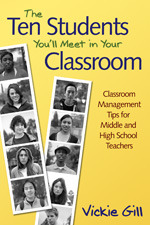The Ten Students You'll Meet in Your Classroom
Classroom Management Tips for Middle and High School Teachers
Student Behavior
"Has an excellent mix of humor and seriousness to appreciate the students who enter the classroom. Each chapter ends with great ideas for improving connections to understand and educate learners in today's classrooms."
—Brenda Vatthauer, Teacher, Thief River Falls School, MN
"Vickie Gill makes so much sense, I found myself nodding in agreement. This book makes you glad that you read it and is one that teachers will pass on or recommend to their colleagues."
—Melanie Mares, Language Arts Teacher, Lowndes Middle School, Valdosta, GA
Rebels, invisibles, and perfectionists: Do you have any of these in your classroom?
Today's classroom is a mosaic of different types of students, each with different needs and learning styles. While this variety can facilitate an exciting and dynamic teaching experience, it can also present unexpected challenges for any teacher.
In this brief and engaging text, Vickie Gill presents ten student archetypes to help teachers better understand and reach each member of their classrooms. Although students are unique and never fit neatly into one type, Gill shows teachers how to best work with students who exhibit certain kinds of behaviors. Written in a warm and encouraging style, this motivational resource provides both aspiring and veteran teachers with:
- Humorous and poignant stories
- Advice and specific classroom management strategies for each student type
- Sample lessons, activities, assignments, rubrics, and evaluations to reach even the most challenging students
Discover how to engage all student types by appreciating their unique needs and characteristics.
"Has an excellent mix of humor and seriousness to appreciate the students who enter the classroom. Each chapter ends with great ideas for improving connections to understand and educate students in today's classrooms."
"Vickie Gill makes so much sense, I found myself nodding in agreement. This book leaves you glad that you read it and is one that teachers will pass on or recommend to their colleagues."
"While there is no pat formula involved, the approach does help teachers identify and more effectively work with common patterns of behavior and learning: add case histories and you have an excellent real-world survey."
